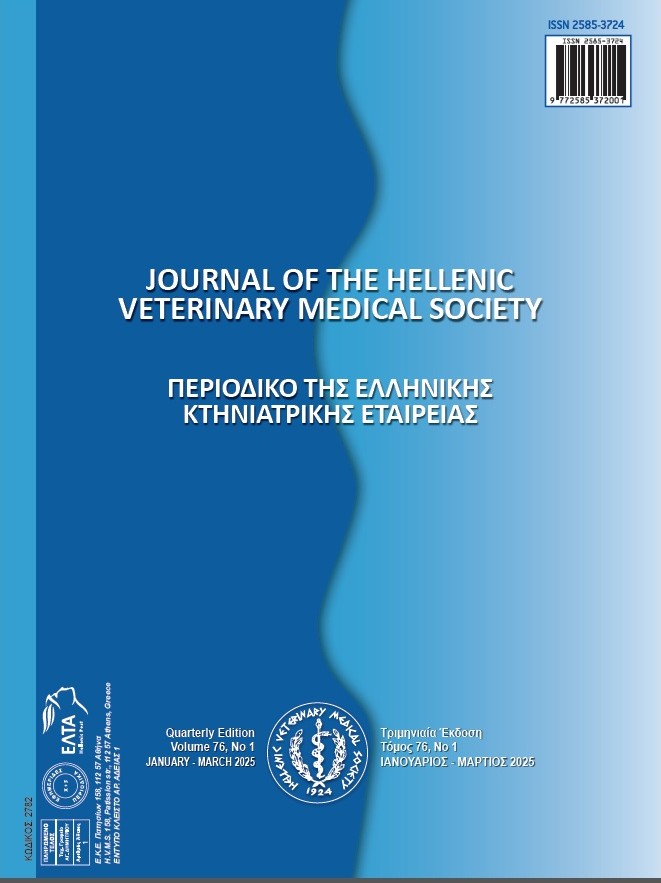Clinicopathological and biochemical evaluation of Feline Infectious Peritonitis in Turkish Van cats
Περίληψη
This study was performed to investigate serum homocysteine and nitric oxide levels in cats with Feline Infectious Peritonitis and present some biochemical and pathological alterations related to the disease. The animal material of this study consisted of thirty Turkish Van Cats of different ages and genders that were definitely diagnosed with the disease by post-mortem examinations and immunohistochemistry. The control group consisted of 6 healthy Turkish Van Cats of different ages and genders that were brought for routine clinical examination. Cats in the study group had clinical findings such as loss of appetite, weight loss, high fever, fever not reduced despite antibiotics, jaundice, dehydration, vomiting, respiratory system symptoms, anemia, nervous findings, uveitis, and ascites. These cats were monitored and following the death, post-mortem examinations were performed and cases with a definitive diagnosis were included in the study. Among the cats consisting study group, while 25 had the dry form of the disease, 5 had wet form. According to the hematological results, there was a statistically significant reduction in platelet counts. The biochemical results showed statistically significant alterations that creatinine, aspartate aminotransferase, alkaline phosphatase, creatine kinase myocardial band, homocysteine, and nitric oxide concentrations were higher than the control group. Besides albumin concentrations were lower and the albumin/globulin ratio was 0.53. As a result; this is the first detailed study in Turkish Van Cats with Feline Infectious Peritonitis that evaluated clinical, hematological, biochemical, and pathological findings. Furthermore, serum homocysteine and nitric oxide levels were evaluated for the first time in cats with vasculitis which is the most important complication of the disease. It is concluded that the evaluation of serum homocysteine and nitric oxide concentrations in Feline Infectious Peritonitis may assist the antemortem diagnosis of the disease.
Λεπτομέρειες άρθρου
- Πώς να δημιουργήσετε Αναφορές
-
Özbek, M., Özkan, C., Kaya, A., Yıldırım, S., Kozat, S., & Akgül, Y. (2022). Clinicopathological and biochemical evaluation of Feline Infectious Peritonitis in Turkish Van cats . Περιοδικό της Ελληνικής Κτηνιατρικής Εταιρείας, 73(3), 4379–4388. https://doi.org/10.12681/jhvms.27159
- Τεύχος
- Τόμ. 73 Αρ. 3 (2022)
- Ενότητα
- Research Articles

Αυτή η εργασία είναι αδειοδοτημένη υπό το CC Αναφορά Δημιουργού – Μη Εμπορική Χρήση 4.0.
Οι συγγραφείς των άρθρων που δημοσιεύονται στο περιοδικό διατηρούν τα δικαιώματα πνευματικής ιδιοκτησίας επί των άρθρων τους, δίνοντας στο περιοδικό το δικαίωμα της πρώτης δημοσίευσης.
Άρθρα που δημοσιεύονται στο περιοδικό διατίθενται με άδεια Creative Commons 4.0 Non Commercial και σύμφωνα με την άδεια μπορούν να χρησιμοποιούνται ελεύθερα, με αναφορά στο/στη συγγραφέα και στην πρώτη δημοσίευση για μη κερδοσκοπικούς σκοπούς.
Οι συγγραφείς μπορούν να καταθέσουν το άρθρο σε ιδρυματικό ή άλλο αποθετήριο ή/και να το δημοσιεύσουν σε άλλη έκδοση, με υποχρεωτική την αναφορά πρώτης δημοσίευσης στο J Hellenic Vet Med Soc
Οι συγγραφείς ενθαρρύνονται να καταθέσουν σε αποθετήριο ή να δημοσιεύσουν την εργασία τους στο διαδίκτυο πριν ή κατά τη διαδικασία υποβολής και αξιολόγησής της.






